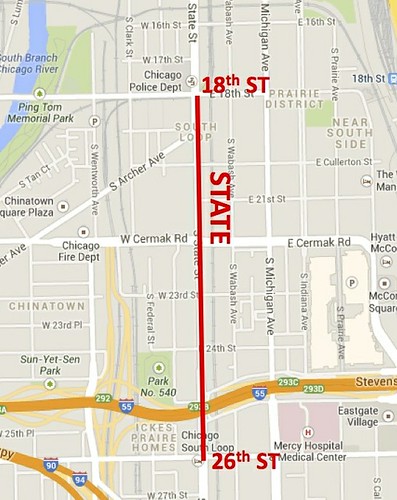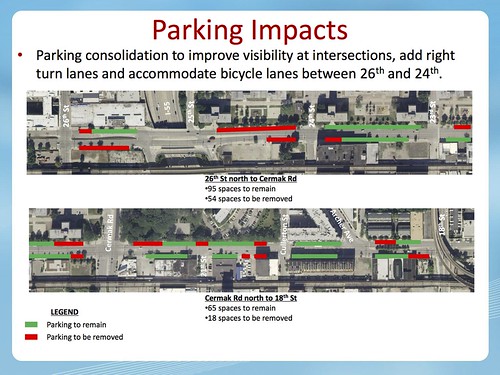If support from aldermen Patricia Dowell (3rd) and Will Burns (4th) expressed at a public meeting on Tuesday is any indication, it should be relatively easy for the Chicago Department of Transportation to install buffered and protected bike lanes along State Street from 18th to 26th streets. This eight-block stretch is .8 miles long, since blocks are shorter than usual on the Near South Side.
In February 2012 CDOT proposed installing protected lanes along Martin Luther King Drive, half a mile east of State, from 26th to 51st streets in her in Dowell's ward. But local church leaders opposed the lanes because they feared they would affect Sunday parking and detract from the aesthetics of the historic boulevard, according to CDOT Project Manager Mike Amsden. As a result, the project stalled. After the advocacy group Bikes Belong sent Dowell and other local politicians on a research trip to Denmark that June, she came back enthusiastic about transportation cycling and agreed to allow buffered lanes on King and protected lanes on State.
CDOT staffers Nathan Roseberry and John Wirtz presented on the State Street plan at the info session at Columbia College, which also included details on the city’s first raised bike lane on Roosevelt. Lanes with two-foot buffers on each side will be installed from 18th to Cullerton Street (2000 South). Curbside, six-foot-wide protected lanes, with a three-foot buffer between the lanes and parked cars, will go in between Cullerton and 26th Street.
An innovative aspect of this project is the removal of several parking spaces near intersections to improve sightlines. Other spots will be removed at sites where there are concrete medians, and next to new bus stops. CDOT will also remove parking next to vacant lots on the west side of State from 24th Street to 25th Street. This undeveloped land was the site of the Harold Ickes Homes housing project before the buildings were demolished in the late 2000s as part of the Chicago Housing Authority’s so-called Plan for Transformation.
The project also involves a road diet, converting four travel lanes to two through lanes plus turn lanes. CDOT says four-to-three conversions can be implemented on roads with up to 20,000 motor vehicles per day without adversely affecting traffic flow, and this stretch of State has only 12,600. Roseberry described the road diet as a way to “take advantage of a road with unnecessary travel lanes and use those for better uses.”
In keeping with the department’s current focus on complete streets, the project will also benefit pedestrians. The bike lanes will mean shorter crossing distances for peds, and workers will stripe high-visibility, zebra-stripe crosswalks. Rosenberg promised these changes would be good for local commerce. “We want to make sure we can help these businesses by improving the street,” he said. “We can really increase those retail sales.” The project is also a win for transit riders. Bus stops will be “rebalanced,” with little used stops, like one in front of the former Ickes Homes site, removed or relocated to speed the buses.
This curb at 18th and Calumet is an obstacle to cyclists heading to the lakefront.
During the Q & A session, many residents and bike commuters voiced support for the improvements and pushed for further changes. These include better connections to the lakefront and existing downtown lanes, as well as adding a curb cut at 18th and Calumet, where cyclists currently need to hop a nine-inch curb to get to a bridge over Metra tracks on the way to the lake. The CDOT staffers said State is slated for more improvements in the future, since it is identified as a bike-priority Spoke Route in the Streets for Cycling 2020 Plan.
While the aldermen have endorsed the project, 3rd and 4th Ward residents should let Dowell and Burns know they support CDOT's plan for aggressive improvements to State, making it better for all road users. As the King Drive experience with shows, it only takes a handful of opponents to water down a good sustainable transportation project.







